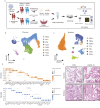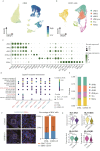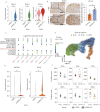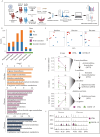Immune rebalancing at the maternal-fetal interface of maternal SARS-CoV-2 infection during early pregnancy
- PMID: 38441496
- PMCID: PMC11131034
- DOI: 10.1093/procel/pwae006
Immune rebalancing at the maternal-fetal interface of maternal SARS-CoV-2 infection during early pregnancy
Abstract
The current coronavirus disease 2019 (COVID-19) pandemic caused by severe acute respiratory syndrome coronavirus (SARS-CoV-2) remains a threat to pregnant women. However, the impact of early pregnancy SARS-CoV-2 infection on the maternal-fetal interface remains poorly understood. Here, we present a comprehensive analysis of single-cell transcriptomics and metabolomics in placental samples infected with SARS-CoV-2 during early pregnancy. Compared to control placentas, SARS-CoV-2 infection elicited immune responses at the maternal-fetal interface and induced metabolic alterations in amino acid and phospholipid profiles during the initial weeks post-infection. However, subsequent immune cell activation and heightened immune tolerance in trophoblast cells established a novel dynamic equilibrium that mitigated the impact on the maternal-fetal interface. Notably, the immune response and metabolic alterations at the maternal-fetal interface exhibited a gradual decline during the second trimester. Our study underscores the adaptive immune tolerance mechanisms and establishment of immunological balance during the first two trimesters following maternal SARS-CoV-2 infection.
Keywords: SARS; fetal; immune; interface; maternal; rebalancing.
© The Author(s) 2024. Published by Oxford University Press on behalf of Higher Education Press.
Conflict of interest statement
The authors declare that they have no conflicts of interest.
Figures






References
-
- Ashkar AA, Croy BA.. Interferon-gamma contributes to the normalcy of murine pregnancy. Biol Reprod 1999;61:493–502. - PubMed
MeSH terms
Grants and funding
- 2022YFC2702200/Ministry of Science and Technology of China
- 82022027/National Natural Science Foundation of China
- 19JC1415300/Science and Technology of Shanghai Municipality
- 2017ZZ02015/Shanghai Municipal Medical and Health Discipline Construction Projects
- 2023M732660/China Postdoctoral Science Foundation
LinkOut - more resources
Full Text Sources
Medical
Miscellaneous

